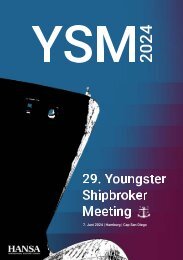HANSA 10-2017
Fährschifffahrt | Brexit | HIPER | Schifffahrt der Zukunft | Börsenbericht | US Ports & Hurricanes | Abwasser | Häfen Niedersachsen | HVAC | Job-Börse | Offshore-Marktkompass
Fährschifffahrt | Brexit | HIPER | Schifffahrt der Zukunft | Börsenbericht | US Ports & Hurricanes | Abwasser | Häfen Niedersachsen | HVAC | Job-Börse | Offshore-Marktkompass
Erfolgreiche ePaper selbst erstellen
Machen Sie aus Ihren PDF Publikationen ein blätterbares Flipbook mit unserer einzigartigen Google optimierten e-Paper Software.
Schiffstechnik | Ship Technology<br />
MAN reveals new flagship engine<br />
The successor to the 48/60CR engine continues features, such as a common-rail system with<br />
Ecomap capability, and adds new technologies, such as two-stage turbocharging<br />
MAN Diesel & Turbo states that the<br />
45/60CR’s power increase and low<br />
consumption are particularly aimed at<br />
such key, lifecycle-cost-oriented applications<br />
as cruise liners, RoPax ferries,<br />
RoRo vessels, and dredgers. The company<br />
is making the 45/60CR engine available<br />
first as 12 V and 14 V versions with<br />
6 L to <strong>10</strong> L variants to follow later. The engine<br />
has been conceived from the beginning<br />
as a family concept that will accommodate<br />
future derivatives (e.g. dual-fuel).<br />
Gunnar Stiesch, Head of Engineering<br />
Engines at MAN Diesel & Turbo, says:<br />
»Next to a frontloading approach, using<br />
thermodynamic engine process calculations,<br />
we used computational fluid dynamics<br />
to simulate and optimize the combustion<br />
process. Also, finite elements analysis<br />
was used to optimize the engine’s mechanical<br />
strength and vibration behavior. We<br />
then put the power unit to the test on the<br />
world’s largest, four-stroke, single-cylinder<br />
test engine and started the experimental<br />
optimization and validation phase.«<br />
The two-stage turbocharger module<br />
rounds off the 45/60CR’s profile. »Despite<br />
the turbocharging being two-stage, load<br />
pick-up behaviour is the same as for the<br />
single-stage turbocharged 48/60CR engine.<br />
Operators thus profit from maximized<br />
peak pressure and optimal utilization<br />
of the Miller Cycle«, explains Stiesch.<br />
The V45/60CR enables owners and operators<br />
to meet demands of more stringent<br />
emissions regulations, while simultaneously<br />
optimizing operating expenses with<br />
low levels of fuel-consumption. Through<br />
increasing standardization and using modular<br />
sub-components, it also allows faster<br />
installation and easier maintenance,<br />
MAN says. The new four-stroke unit<br />
meets IMO Tier II, while IMO Tier III is<br />
met with MAN’s in-house, compact SCR<br />
system; it is shortly scheduled for approval<br />
by all major classification societies.<br />
According to MAN the 45/60CR is suitable<br />
for use in a wide range of marine<br />
applications, especially applications with<br />
high power-demands like modern cruise<br />
vessels, large RoPax and RoRo ferries,<br />
as well as mega-dredgers. Calculations,<br />
based on a representative load-profile of<br />
a cruise vessel, show that a ship operating<br />
with an 45/60CR engine can enjoy a fueloil<br />
cost benefit of 5 to 12% in comparison<br />
with a vessel powered by an equivalent<br />
engine from other manufacturers. For a<br />
cruise vessel of around 120,000-150,000 gt<br />
with 60-65 MW of installed power and an<br />
assumed fuel price of 500 €/t, this translates<br />
into annual savings of 0.9 to 2.4 mill. €<br />
when employing the 45/60CR.<br />
The engine combines the characteristics<br />
of its predecessor (48/60CR) – including<br />
its in-house common-rail injection<br />
system, with the latest innovations<br />
in diesel-engine technology such as twostage<br />
turbocharging. The V45/60CR can<br />
also be combined with the ECOMAP<br />
2.0 technology that grants operators the<br />
flexibility to run an engine following different<br />
SFOC power characteristics, facilitating<br />
optimal effciency at different<br />
load points. The latest development is<br />
the integration of the SCR system into<br />
ECOMAP, offering even further possibilities<br />
to optimize the effciency of the<br />
propulsion system, taking into account<br />
fuel and urea prices.<br />
The 45/60CR will initially be available<br />
as 12 V and 14 V versions with power outputs<br />
of 15,600 and 18,200 kW respectively,<br />
with inline versions following at a later stage.<br />
The first set of V-type engines will be<br />
available from end-2020 with delivery of<br />
the first L-type engines due from 2022. M<br />
Virides Solution 1/3 hoch in<br />
bestmögl.<br />
<strong>HANSA</strong> International Maritime Journal – 154. Jahrgang – <strong>2017</strong> – Nr. <strong>10</strong> 63


















